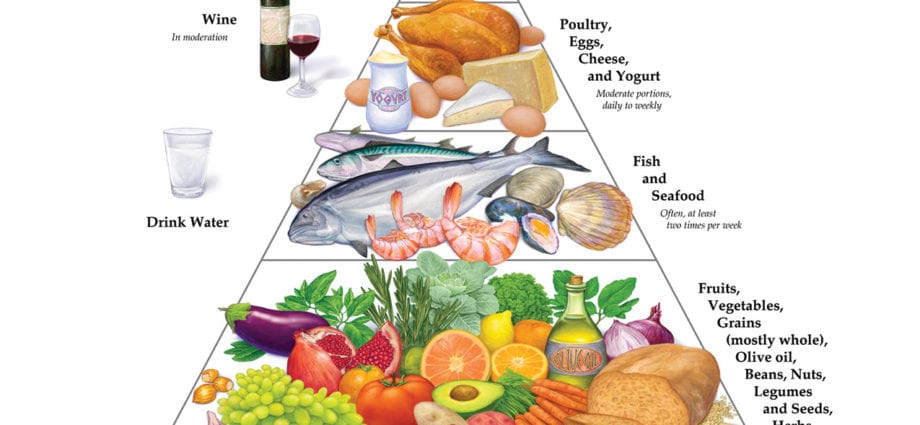Contents
The term “” () introduced. He noticed that the inhabitants of Southern Italy, in contrast to the population of Northern and Central Europe, are much less likely to “” – obesity, atherosclerosis, diabetes and high blood pressure. The doctor suggested that this is due to the dietary habits of southerners, and deduced an amazing pattern: the more the diet differs from the Mediterranean “model”, the higher the level of such diseases.
The peak of popularity of the Mediterranean diet came in the United States in the 60s of the last century. But until now, many nutritionists consider it to be the best, almost ideal model of proper nutrition.
“”, Says Italian doctor Andrea Giselli, an employee of the National Research Institute of Nutrition in Rome (INRAN) and author of the most popular book on healthy eating in the Apennines.
Does not prohibit, but recommends
The first and main difference between the Mediterranean diet and all others is that it does not prohibit anything, but only recommends certain foods for consumption: more healthy vegetable fats and dietary fiber that prevent the formation of free radicals and the occurrence of the so-called “oxidized” stress – the main cause of aging in the body.
Basic foods for the Mediterranean diet
The Mediterranean diet is characterized by the consumption of large amounts of grains, herbs, vegetables and fruits. Animal products (mainly cheese, eggs, fish) should also be included in the daily diet, but in smaller quantities. Most importantly, food should be moderate and balanced.
By following this diet, a person gets most of the energy he needs from grains and products from them – it does not matter if it is pasta in Italy, bread in Greece, couscous in North Africa or corn in Spain.
Must be present at our table every day:
- Fruits and greens
- Cereals, corn, millet
- Milk, yogurt, cheese
- Eggs
- Beef or lamb, sea fish
- Olive oil
Every day at least one product from each group should be on our table.
Italian nutritionists have compiled tables by which you can calculate what and how much should be consumed per day in order to give the body the necessary supply of energy, and at the same time not gain weight.
Table No. 1 RECOMMENDED FOR USE PRODUCTS
| PRODUCT GROUP | PRODUCTS | WEIGHT (PORTION) |
| Cereals and tubers | Bread Biscuit Pasta or rice Potato | 50 gr 20 gr 80-100 gr 200 gr |
| Vegetables | Green salad Fennel / artichokes Apple / orange Apricots / tangerines | 50 gr 250 gr 150 gr 150 gr |
| Meat, fish, eggs and legumes | Meat Sausage Fish Eggs beans | 70 gr 50 gr 100 gr 60 gr 80-120 gr |
| Milk and dairy products | Milk Yogurt Fresh cheese (mozzarella) Mature cheese (gouda) | 125 gr 125 gr 100 gr 50 gr |
| Fats | Olive oil Butter
| 10 gr 10 gr |
Table 2. RECOMMENDED AMOUNT OF FOOD CONSUMPTION BY AGE AND LOAD (servings per day)
| GROUP # 1 1700 Kcal | GROUP # 2 2100 Kcal | GROUP # 3 2600 Kcal | |
| Cereals, grains and vegetables Bread Biscuit Pasta / fig
| 3 1 1
| 5 1 1
| 6 2 1-2
|
| Vegetables and fruits Vegetables / greens Fruit / fruit juices | 2 3 | 2 3 | 2 4 |
| Meat, fish, eggs and legumes | 1-2 | 2 | 2 |
| Milk and dairy products Milk / yogurt Fresh cheese Mature cheese (hard) | 3 2 2 | 3 3 3 | 3 3 4 |
| Fats | 3 | 3 | 4
|
Group # 1 – recommended for children over 6 years old, as well as elderly women who lead a physically inactive lifestyle.
Group # 2 – recommended for young girls and women with an active lifestyle, as well as men, including the elderly, with a sedentary lifestyle
Group # 3 – recommended for young people and men leading an active lifestyle, including those who regularly go in for sports
Residents of the rural south of Italy rarely suffer from obesity, atherosclerosis, diabetes and high blood pressure. For this, they must thank their food system, which the inhabitants of other countries have called the Mediterranean diet.










